
Lynchburg is an independent city in the Commonwealth of Virginia in the United States. First settled in 1757 by ferry owner John Lynch, the city's population was 79,009 at the 2020 census, making Lynchburg the 11th most populous city in Virginia. Located in the foothills of the Blue Ridge Mountains along the banks of the James River, Lynchburg is known as the "City of Seven Hills" or the "Hill City". In the 1860s, Lynchburg was the only city in Virginia that was not recaptured by the Union before the end of the American Civil War.

Amherst is a town in Amherst County, Virginia, United States. The population was 2,231 at the 2010 census. It is the county seat of Amherst County.
The University of Lynchburg, formerly Lynchburg College, is a private university associated with the Christian Church and located in Lynchburg, Virginia. It has approximately 2,800 undergraduate and graduate students. The university's campus spans 264 acres.

Virginia University of Lynchburg is a private historically black Christian university in Lynchburg, Virginia. The university is accredited by the Transnational Association of Christian Colleges and Schools and offers instruction and degrees, primarily in religious studies, including a Doctorate of Ministry program. The campus is a historic district listed on the National Register of Historic Places.

Buildings, sites, districts, and objects in Virginia listed on the National Register of Historic Places:

The Stonewall Jackson's Headquarters Museum is a historic house located at 415 North Braddock Street in the Historic District of Winchester, Virginia.

The Anne Spencer House, in Lynchburg, Virginia, United States was, from 1903 to 1975, the home of Anne Spencer, a poet of the Harlem Renaissance. The house opened as a museum in 1977.
This is an incomplete list of historic properties and districts at United States colleges and universities that are listed on the National Register of Historic Places (NRHP). This includes National Historic Landmarks (NHLs) and other National Register of Historic Places listings. It includes listings at current and former educational institutions.

Carter Glass House is a historic house at 605 Clay Street in Lynchburg, Virginia. Built in 1827, it is nationally significant as the longtime home of United States Congressman, Senator, and Treasury Secretary Carter Glass (1858-1946), who championed creation of the Federal Reserve System and passage of the Glass-Steagall Act, which constrained banking activities. The house was designated a National Historic Landmark in 1976. It now serves as a parish hall for the adjacent St. Paul's Church.
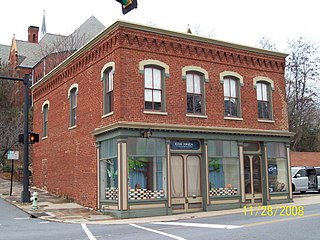
The Bragassa Toy Store is a historic commercial building located in Lynchburg, Virginia. In 1871, Francisco Bragassa purchased the property and in 1875 to 1876, he built the confectionery and toy store in Italianate style. The Bragassa store was at the center of a new, expanding commercial section of town during the Reconstruction period. It is the only surviving building within a four-block area that represents this commercial expansion. The building contains comfortable living quarters upstairs, with the merchandise on the ground floor. At the front of the shop were the first plate glass windows ever installed in Lynchburg. The store remained in the Bragassa family until 1987. In January 1988 the Lynchburg Historical Foundation purchased the building from the Bragassa family. In November 2008, the building was occupied by Kid's Haven: A Center for Grieving Children.
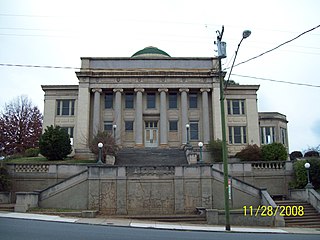
Jones Memorial Library is a specialized genealogy and history research library currently located at 2311 Memorial Avenue in Lynchburg, Virginia.
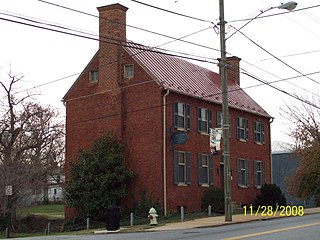
The Kentucky Hotel is a historic hotel building located at Lynchburg, Virginia. It is one of Lynchburg's three remaining early 19th century ordinaries. It was probably built before 1800, and is a 2+1⁄2-story structure of brick laid in Flemish bond. In about 1814, two side bays were completed, converting the house to a center hall plan.

St. Paul's Church is a historic Episcopal church in Lynchburg, Virginia, United States.

The Lynchburg Courthouse is a historic courthouse building located at Lynchburg, Virginia. Built in 1855, it occupies a prominent position overlooking the steeply descending steps of Monument Terrace. The building is executed in stucco-over-brick on a granite ashlar basement and is an example of the Greek Revival. The building is capped by a shallow dome located over the intersection of the ridges. At the top of the dome is a small open belfry consisting of a circle of small Ionic columns supporting a hemispherical dome. The front of the court house has a three-bay Doric portico.
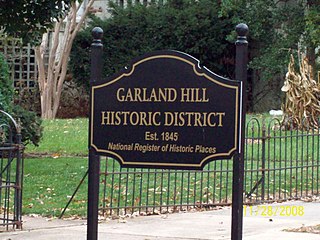
The Garland Hill Historic District is a national historic district located in Lynchburg, Virginia. The area is a small residential neighborhood incorporating the summit of one of the numerous hills surround downtown Lynchburg. The neighborhood was home to many of Lynchburg's oldest and most distinguished families, many of whom were associated with the tobacco industry. Buildings in the district represent a variety of styles from the early 19th century through the early 20th century including the Gothic Revival, Victorian, and Queen Anne styles, some of which were designed by Lynchburg architects Edward Frye and Stanhope S. Johnson.
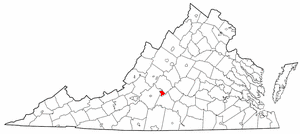
This is a list of the National Register of Historic Places listings in Lynchburg, Virginia.

The Rivermont Historic District is a national historic district located in Lynchburg, Virginia. It is a 192.10-acre (0.7774 km2) district consisting of the 300-3400 blocks of Rivermont Avenue as well as Riverside Park and a few properties alongside streets that face onto Rivermont Avenue. It is bounded by the James River on the east and northeast, Blackwater Creek on the east and southeast, Daniel's Hill on the north and Virginia Episcopal Road and the southern end of Boonesboro Road.

The Main Hall is a historic building located on the campus of Randolph College in Lynchburg, Virginia. It was built between 1891 and 1911, and is a large Queen Anne style brick building complex. The central entrance tower and eastern wings were constructed between 1891–1893. Two additional wings were added to the west in 1896. With the erection of a wing to the west in 1899, the building was completed according to the original plan. In 1911 an annex was added to the rear of the entrance pavilion. Further additions and renovations were made to the north elevation in 1936. Its most distinctive features is the central entrance tower with a front portico and topped by a parapet wall and capped by a classically inspired wooden cupola, crowned by a finial.
Hopwood Hall is a Grade II* historic house in Middleton, Greater Manchester, England, which was the ancestral country home of the landed gentry family of Hopwood who held it from the 12th century, passing to the Gregge family and remaining in their possession until it was closed up in 1922. The Hall was sold in 1946, and after a series of temporary residents, by the 1980s it had fallen into disrepair; in 2018 it was placed under renovation by the new owner, an American actor who is descended from the Hopwoods through John Hopwood (1745–1802).
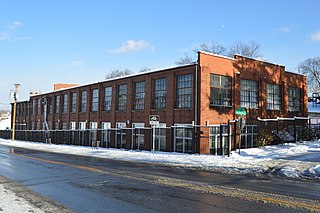
The Lynchburg Hosiery Mill No. 1 is a historic industrial property at 2734 Fort Avenue in Lynchburg, Virginia. The 4-acre (1.6 ha) property includes two early 20th-century brick buildings whose construction history dates to 1900, although the oldest surviving portions now date to the 1920s. It was one of the first hosiery factories established in the American South, producing socks for the United States Army during World War I. The mill was closed in 1972 and partially destroyed by fire in 1980.




















